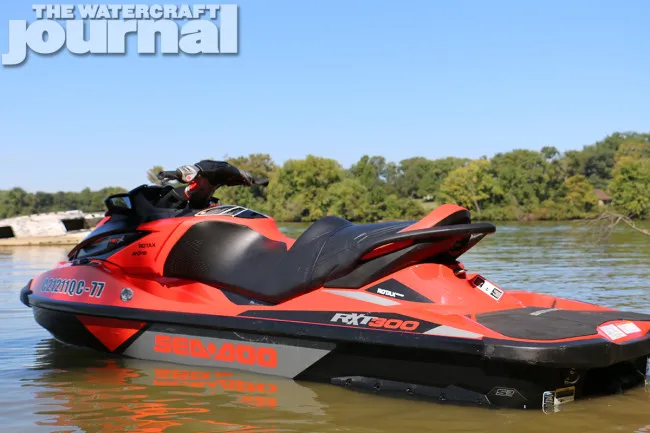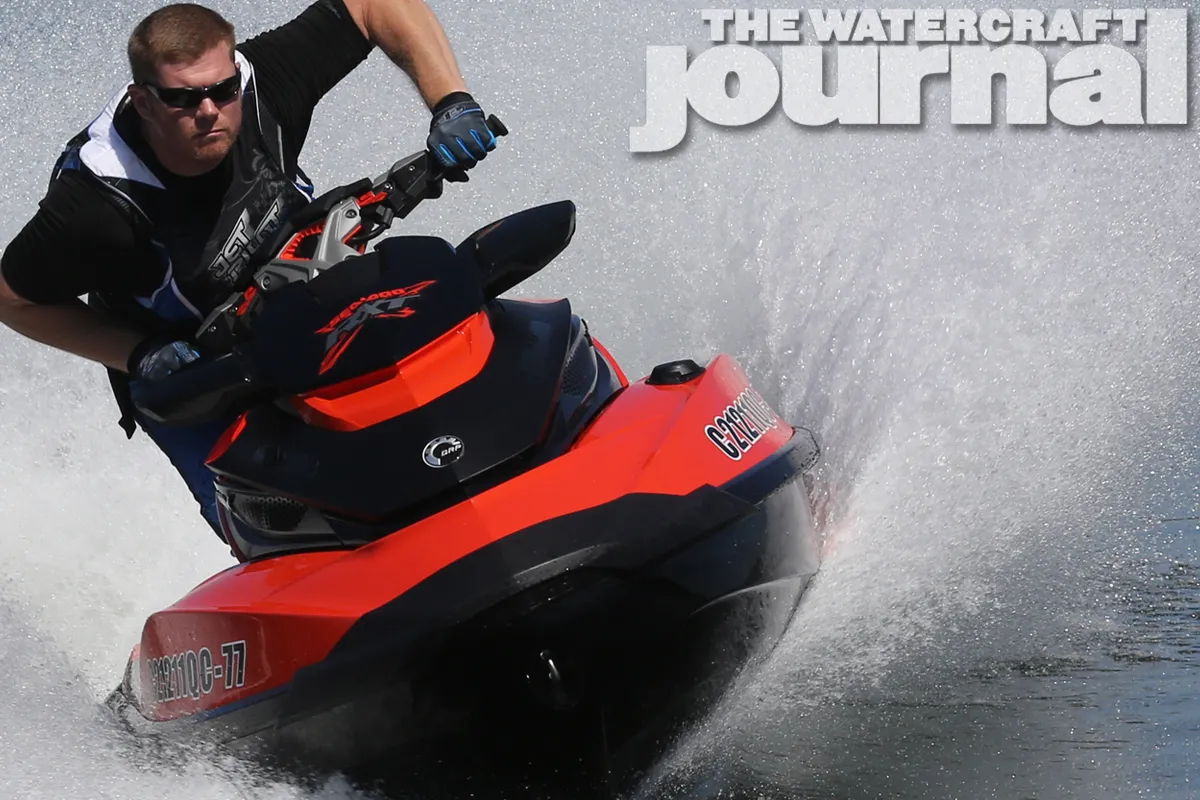How do you get a middleweight boxer to hit like a heavyweight and be as light on his feet as a featherweight? That, we presume was the challenge pinned to the board in Sea-Doo’s new product development office a few years back. The evolutionary step from last year’s RXT-X 260 to the 2016 Sea-Doo RXT-X 300 of today is far more than horsepower and deserves some further understanding.
Back in 2010, with the 260 model replacing the outgoing 255 RXT-X, the change also heralded the use of the S3 hull married to a fixed-deck (2009 had the S3 exclusive to the RXT-X iS 260 and GTX iS 260). The move was one of Sea-Doo’s more exciting announcements, as it included the widespread use of BRP’s Intelligent Throttle Control (iTC), 5-point tilt steering that encompassed the gauge cluster, and a hinged, single-piece seat.
Besides the bump in performance, the new 2010 RXT-X 260 was long, lean and strikingly aggressive in both looks and performance. But as the past five years rolled past, Sea-Doo’s Performance segment flagship started to slink into the background behind SVHO-powered FX Yamahas and 310-horsepower Kawasakis. If the RXT-X was to reclaim its crown, something needed to be done.
As The Watercraft Journal predicted, a new ACE engine from Rotax came, and with it a true 300-horsepower. Outlined in our comprehensive unveiling of the complete 2016 Sea-Doo lineup last month, Rotax completely rethought its 14-year-old 1503 4tec 3-cylinder. (The engine remains in all non-300HP 2016 models.) Now, the new 1630 ACE 300 pushes the RXT-X (as well as its luxurious sibling, the GTX 300 Limited and aforementioned RXP-X 300) to new heights.
Above left: The new 1630cc ACE motor produces 15-percent more power than the outgoing 1503 Rotax. Above center (and top): The new intercooler features sacrificial nodes, and more than double the cooling capacity of the previous intercooler. It is also available as a retroactive replacement for 260 and 255 models. Above right: The revised flush-mounted hood is not only attractive but purposeful, as a small number of riders had the heavy overhanging top fairing blown off by oncoming waves.
An increased 69.2mm stroke (over the previous 63.4mm), gives the new 1630.5cc ACE its 9-percent added displacement. To offset the larger crank’s throw, shorter, lighter connecting rods topped with more robust, but 20 grams lighter 100mm pistons. Combined with an additional cooling circuit, a single-stage dry sump oiling system, larger heat extractor, and a new, larger intercooler that is 2.2-times more efficient with over twice the capacity, equals 33-percent improved engine cooling, and subsequently, 15-percent more power.
Well, not entirely. A large contributor to the added power is due to redesigned centrifugal supercharger that produces 30-percent more boost (18psi). A new compact wheel spins 8-percent faster at 47,000rpm. The new efficient design features twice the blades of the outgoing design (from 16 to 32) and a revised drive shaft that rides on two composite bearing packs at either end of a near inch-thick shaft, engaged by 8 steel clutch washers.
As per BRP’s Engineering Director for the new engine, Martin Lachance, all superchargers are dynamically balanced prior to assembly, assuring that they are, in fact, “maintenance free.” Of course, there are larger changes to the ACE motor’s single-camshaft top end, including a new combustion chamber design, new larger injectors, and a new coil-on-plug direct-ignition system that produces double the ignition energy for a hotter, more efficient burn.
Equally, Rotax minimized both weight and internal engine temperatures by replacing the pressed-in steel sleeves with a new plasma coating created by Rotax’s team in Gunskirchen, Austria. Applied through a proprietary thermal spraying process, the coating not only saves weight from the heavy steel sleeves, but improves surface durability, minimizes friction and increases heat transference.
Above left: The foot wedges help angle the rider’s knees inward to pinch the seat like a sportbike. Above right: Accommodating the new Ergolock seat resulted in enlarging the glove box. The iPhone 5S is to show scale. It’s possibly the biggest glovebox on the market today.
All of this results in a arm-stretching amount of mid-range power, continually pulling upward along its ascending torque curve. Staving off cavitation is the 10-vane stator, multi-diffuser venturi, new 159.5mm prop and larger diameter wear ring identical to the RXP-X 300, keeping the RXT-X’s pump loaded and biting hard, be it in a straightaway, in the apex of a turn or rocketing through chop.
Yet again, the 2016 RXT-X 300 isn’t merely an increase in horsepower, but so much more – particularly to rider ergonomics. Sea-Doo has already applied its multi-point-of-adjustment AES (Adjustable Ergonomic Steering) handlebar to the RXT-X back in 2010, its eight points of adjustment permiting for dozens of configurations (to handlebar grip width and angle). The addition of new palm wedges molded into the grips being new.

Likewise, the integration of the iControl controls into the AES handlebars – allowing iTC commands for Touring, Sport and ECO engine tunes, on-demand trim settings via the VTS system, and toggles for the in-dash controls (RPM, MPH, MPG, and fastest lap time counter). Identical to the RXP-X, boost gauge tops the LCD screen flanked by an easy-to-read analog speedometer and tachometer.
But the big change to the RXT-X’s ergonomics is found in the seat and footwells. By incorporating its Ergolock seating system and accompanying foot wedges from the RXP-X, the new RXT-X (and all S3-hulled machines) now allows the rider to use their knees and thighs to pinch the narrow saddle just like the sportier P-X. The result is a dramatic difference in rider input and comfort, particularly while cutting a tight corner.
To allows for the new hourglass-shaped Ergolock seat, Sea-Doo needed to expand the fairings, consequently nearly doubling the glovebox capacity. Together with a new, completely furnished front storage in the box not only permits stowage of Sea-Doo’s removable watertight bin, but under it as well. This adds up to three times more total capacity than before (42.8 gallons).
In a surprising turn of events, the 2016 RXT-X 300 actually weighs less than the outgoing 2015 RXT-X 260 by an impressive 35 pounds (850 lbs. vs. 885 lbs.). Contributors to the weight savings are found in the relocation of the battery fore of the engine and the new second-generation iBR (Intelligent Brake & Reverse) motor located over the pump tunnel, thus removing the rear access panels.
Above: Here you can see how Sea-Doo’s RXT-X 300 not only offers its watertight, sealed storage bin (hat shown for scale), but now features a fully furnished storage cabin beneath the bin, which can house a full-sized PWC cover.
Of which, the new iBR employs a redesigned three-piece bucket system that deploys to slow the RXT-X 160-feet shorter than other non-brake equipped watercraft. New too are the motor, actuators and mounting hardware, all in an effort to successfully eliminate the heavy nose-plowing of the previous iBR-equipped runabouts.
In all fairness, our review of the 2016 RXT-X 300 should’ve been published first. It is after all, the ski Sea-Doo introduced to us before the others, and as you might’ve already seen, features the most improvements and innovation over its previous model than the RXP-X. (We just knew more people would want to see the 2016 P-X first.)

Although the hull and adjustable sponsons remain untouched, the addition of the 300-horsepower ACE motor, larger prop, improved (and lightened) weight distribution and rider positioning radically changes how the RXT-X enter, banks and exits a turn. Employing the full use of the Ergolock seat, and centering ourselves forward over the handlebars, the large RXT-X snapped corners like a craft three-quarters its size.
Although we had our choice of either Lava Red/Satin Black or White/Dayglow Yellow, the former is our personal favorite. Priced at $15,399 MSRP, the price is a $400 hike from the outgoing model, but the weight savings, horsepower increase, and added innovation more than equates for the jump in our view.
All-in-all, we couldn’t help but gush over the newest RXT-X and feel its possibly Sea-Doo’s best performance-bred three-seater to date. It was the first of the 2016 lineup we wanted to ride, and after two days of hammering on it, remained our favorite until we were asked to give it back – and we’re pretty sure you’ll feel the same way.






























































